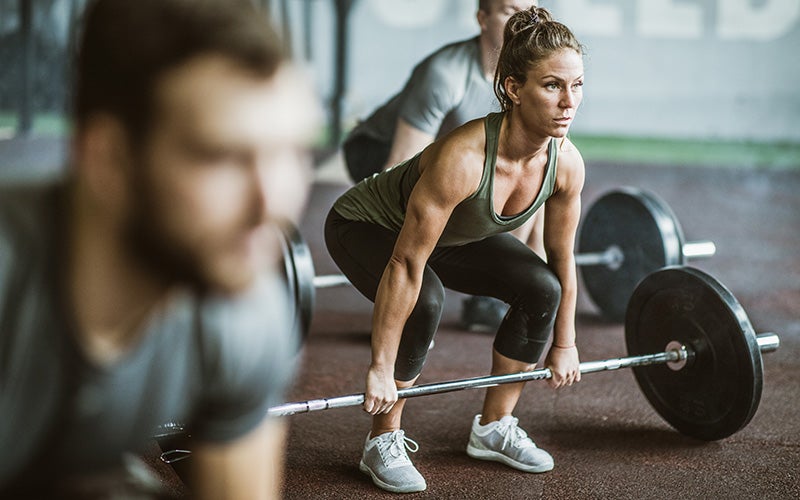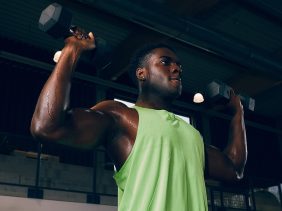Get to Know the Romanian Deadlift
 ©skynesher
©skynesher
If you’re looking for more hamstrings work on Leg Day, you’ve got to add the Romanian deadlift into your repertoire. Here’s how to do it safely and effectively.
What is Romanian deadlift?
The lift is a modification of the classic deadlift. The biggest difference happens at the knees, which remain semi-extended the whole time. This change takes some of the force off of the thighs and puts more strain on your hamstrings.
Fun fact: The Romanian deadlift has only been around since 1990. US Olympic weightlifting coach Jim Schmitz invited Romanian weightlifter Nicu Vlad over to his home so he could show off his training technique to other athletes. Following his demo, Vlad knocked out a few more reps of the Romanian deadlift as we know it today, which he and his trainer developed to help him strengthen his back and work on his clean and jerk. This variant was not even known to those present, but now it’s become ubiquitous for people wanting to work on their Olympic lifts, train their hamstrings, or give some extra love to their glutes.
Related: To build strong shoulders, core and endurance, hit the plank
What does Romanian deadlift train?
Hamstrings, of course, and glutes as well. It also helps train grip strength, so if you’ve been having trouble finishing out sets of barbell rows, this will help get you there. The move also requires you to get to full hip lockout so that joint gets worked, too. During the lift, you need to keep your shoulders engaged, low-back neutral, and spine flexible.
And as Vlad identified, it helps train the first part of the clean and jerk. That means your arms and shoulder joint stabilizers are firing in order to keep the barbell close to your shins, and your core needs to be strong in order to back up all the work that’s happening on the back half of your body. It’s a good way to feel out how wide the feet should be to generate power, since the force comes through the hamstrings and glutes, and uses the floor to push off of.
How to do the lift
Start by warming up legs, hips, and shoulders for 10 minutes. Use a dowel to do a few squats, good mornings, and shoulder circles. If you’ve never done a Romanian deadlift, and are new to clean and jerks, use a dowel or light, empty barbell to understand the movement pattern, paying special attention to the closeness the bar travels to your legs.
Let’s get lifting. Set up in a traditional deadlift position, then step slightly forward so ankles are touching the barbell, hands in the overhand grip just outside of the calves. Lock arms out, pull shoulder blades back and down, keep gaze out and toward the floor, and engage arms, chest, and core to set up. Keeping hips high, knees soft, engage glutes to perform a deadlift and bring the barbell to top position.
Refuel: Try our whey protein either before or after exercising
From there, set up for the Romanian deadlift. Keeping knees soft but legs mostly straight, barbell close to thighs, lower barbell a few inches under knees. To do the lift, maintaining leg extension, tight shoulder blades, and strong torso, press hips forward to raise the bar. The end of the lift is when hips are fully locked out.
This is a lift that’s done at a controlled pace going down, and fast and powerfully back up. Technique is very important, so make sure you lock in the barbell’s path before you start adding weight.
Find your peak strength with our Body Check. Find it here!
Common pitfalls
- A back that’s rounded. If that happens, the load on your intervertebral discs increases. Make sure to keep your torso straight and tense throughout the exercise. Always maintain a slight hollow back and stretch out your chest.
- Legs are fully extended or bent too much. If the barbell gets heavy and the legs are fully extended, it places too big of a load on the joints. If the knees have too much of a bend, you’re basically doing a traditional deadlift so the hamstring activation is reduced.
- The bar is too far away from your body. The barbell should travel down your thighs, over the knees, and along the shin. If it drifts too far forward, it puts too much pressure on the spine. If you’ve put on weight plates and the bar is traveling far away from your body during the descent, it could be that your shoulders aren’t engaged enough, or aren’t quite ready for that much weight.
These supplements will help keep your body on tip-top form
Romanian lift not for you?
If you’re having an issue with the barbell position — perhaps you’re rehabbing a biceps issue — and prefer to load the weight on your shoulders, good mornings are a great substitute, according to a paper published in PLoS One. The movement is the same, except the barbell is in the back squat position.
More healthy living tips from foodspring:
- More performance in the gym through mobility training
- The #1 Reason Your Muscles Aren’t Growing
- 6 Surprising Effects Lifting Weights, According to Science
- Push & Pull – The Only 6 Moves Your Need to Know to Build Strength
Sources for this article
We at foodspring use only high-quality sources, including peer-reviewed studies, to support the facts within our articles. Read our editorial policy to learn more about how we fact-check and keep our content accurate, reliable, and trustworthy.
- 1Conor Heffernan: Who created the romanian deadlift? https://physicalculturestudy.com/2016/01/12/who-created-the-romanian-deadlift/↩





























